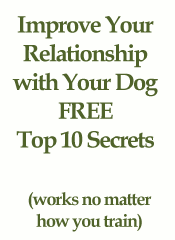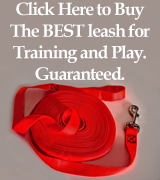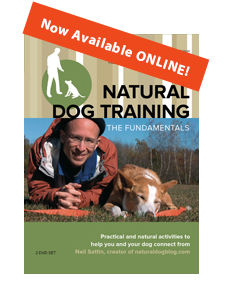We've talked about how our dogs are primarily responding to the emotional energy in the world around them. We've also addressed how a dog needs to be relaxed in order to deal with this energy in a healthy manner (by letting it flow through them), since a physically tense dog will experience excess energy as a building tension that ultimately must be released (typically in some sort of "dysfunctional" behavior). This article is going to give you some quick tips on helping your dog relax.
The two most important things for you are:
1. Develop your ability to sense what's going on with your dog.
In any given situation, is your dog getting more relaxed, or more tense? Do you see muscles trembling? Hair standing on end? Tail quivering? Body wiggling out of control? Spinning around in circles, or manic jumping? Anxious panting? Primarily visual interaction with the world (staring intently)? Shallow breathing? Seeming to be head-oriented, instead of body-oriented? These are all signs of tension, to varying degrees of escalation. Your goal should be to spot warning signs early and nip them in the bud by taking steps to calm the situation. As soon as the tension in your dog has escalated along with the flow of stimulation, you can't expect your dog to listen to you, and it becomes your job to bring them back down to earth before worrying about whether or not they're doing what you ask.
A relaxed dog might have an intensity about them, but it will be a calm, focused intensity, not a building-to-a-flipout kind of intensity. Muscles will be supple, and the dog will be more interested in your contact with their body. A relaxed dog tends to sniff the environment (instead of relying primarily on sight), and will be able to hear you despite whatever else is going on in the world around them. Breathing will be regular, and moments of stillness will be balanced with moments of fluid motion.
2. Develop a state of calm, centered relaxation within yourself.
Our dogs are picking up the emotional energy of the world around them, so who do you think is the major source of that energy? That's right, it's you! Before you pick apart how your dog is reacting in a given situation, examine your own responses. Are you getting tense in a particular part of your body? Are you getting anxious, trying to figure out what to do? Is your breathing rapid and/or shallow? Does your voice get all quick and animated, high pitched? Is the intensity of your interaction building, like by tightening up on the leash, or through verbal escalation? Just like you can't expect your dog to respond correctly when they are in their own fight-or-flight mode, you also can't expect to be capable of asking for the "right" things until you've managed to chill yourself out.
Focus on your breathing. Take time to just notice what's going on within yourself. Don't try to correct it, just notice it, and allow it to be. Accept yourself in your tense state, and recognize your own emotional response to the current environment. Feel your rootedness to the ground, through the weight of your body and the place where your feet are making contact with the earth. Take a drink of water. Shake it out. Let it go. There, feeling better?
OK, those are the basics. Now for some quick nitty-gritty techniques:
1. Play with your dog outside. Try to keep all indoor activity to a minimum. Help your dog work on their "inside voice" vs. their "outside voice".
Here's the reason: our dogs, who were designed to live outdoors, find interior spaces to be quite a bit more stressful, especially as stimulation intensifies. Think about it this way - imagine that you have your stereo on in your living room. You turn the volume up to 6..7..8 - it's getting pretty loud, isn't it? Almost painfully so. However, you could take your stereo outside, at that same level, and it would be much easier to take. In fact, you could probably even turn the volume up without it hurting you. Well, now turn that stereo (sound energy) into play/animated action (emotional energy). With the emotional energy amplified by the walls/floors/ceilings, there's almost no way for a dog to stay relaxed in that environment, which means that they will be storing up stress in their internal battery. That stress needs to come out eventually - and until YOU become the moose in your dog's life that stress will come out in ways that are often not desirable. So...do the play and training, the bulk of your "active" interaction, outside.
2. When you touch your dog, use long, smooth, massaging strokes along the back and sides, the chest, and neck. Keep your touch slow and deliberate, and ever so gradually work your way up to deeper and deeper penetration into the muscle fiber. You are like your dog's massage therapist - working on the physical tension that is the main culprit in dysfunctional behavior. Now, what if you went for a massage, and your massage therapist gave you brisk pats instead of a body rub? It'd have a stimulating effect instead of a relaxing one. Bear that in mind as you massage your dog. Ask yourself if that touch is relaxing or stimulating - and focus on the relaxing techniques.
3. Use treats. When a dog eats, it releases all sorts of beneficial neuro-chemicals into the bloodstream. Treats will also help you get your dog's attention when a situation is getting too intense. You can use the treats to redirect your dog away from whatever is causing the stress, and then use other techniques to deepen the relaxation.
4. Run it out. Fluid motion is a great reliever of stress, and exercise also produces those beneficial neuro-chemicals that I just mentioned. Even walking will help relieve some of the tension in a given situation. Just remember to walk/run AWAY from the source of stress, not towards it! If you need to, use treats to lure your dog into the exercise, but soon the good feeling of the motion will become an enticer all its own.
5. Verbal praise. It's your tone that matters more than your words, so keep your tone even, medium pitched, and relaxed. Repeat "good dog, good dog" over and over (or whatever other POSITIVE phrases you'd like to use). As with everything else, pay attention to the effect your voice is having on your dog. If it's helping to relax them keep it up, if it's not helping then use one of the other techniques.
6. Play, especially tug-of-war. You can play tug of war with your dog while they're on lead. It's helpful to carry a prized tug toy around with you - keep it hidden from your dog, but ready to pull out when needed. Recall that making prey (and biting) is THE chief way that a dog can get relief from their stress...so take out the tug toy, encourage them to bite down, tug a bit, let them win (yes, don't forget to let them win!), and then let them carry the toy around as you walk/jog out some of that tension. Pull on the toy some more. Turn the whole tug/dog wins/verbal praise/jog into a game of its own.
7. Finally - just a reminder - work on your OWN relaxation. Take your time, and as you practice all of these relaxation techniques with your dog, trust that you're getting somewhere. Most of the time, the effects are immediate, but complete change is rarely instantaneous. Be patient with your dog, and yourself.
Thanks again for stopping by, and let me know, either through the comments or e-mailing me (neil at naturaldogblog dot com), if you have any questions or suggestions for new articles.
Preview of what's coming soon: how to introduce your dog to another dog, using a LONG lead, and, at a reader's request, we'll be discussing how to feed your dog - in particular talking about raw food diets.
Keep breathing! 🙂





Hi Neil, I just read the article, but here is an update on what we've been doing pre-article.
I've started using a few squeaky toys inside with Stevie to play a combination of fetch and tug. My kids play just fetch with him, which is amazing, since they generally ignore the dogs, but he is very entertaining.
We're playing inside to limit his options (ADHD poster puppy) and his
physical exertion (the heartworm), although at this point I think moving outside on a 15 ft line would be okay, he is very intent on his toys.
When he has the toys I've been pretty physically intense with him, getting him to accept every kind of touch has been a priority since our last vet visit, he started offering his belly with some initial cajoling yesterday. His mouthing is directed all at the toy 95%- 100% of the time, a monstrous improvement. This is a dog who couldn't be touched anywhere other than his jowls or chest without mouthing or ramping up. I'm tapping nails, poking the belly, simulating injections in muscle tissue and neck skin, and even throwing some round the neck restraints in the mix.
He's developing quite an intensity for one toy and I took it with me on our morning session. It was awesome. I was able to redirect him to the toy, AND he redirected himself to the toy while we stood in a group of four people having a morning chat. After everyone wandered off, he was able to politely greet the remaining person, truly in a calm, relaxed state and offered his belly several times during our chat while chomping on his tug. Probably the first time that has ever happened for him, also, no growling when people approached, another first. Alertness, but easy redirection to the toy.
We've been doing a lot of food work with people coming into his line of sight, so there was some foundation work there that helped.
There are DEFINITELY times when I need to ground myself, do a physical and mental stress check so I am paying a lot of attention to this. In fact, I intend to get back into rock climbing. which scares the hell out of me, just so I have a fresh high end on my chart of truly stressful situations that will make working with Stevie a relief in comparison.
Now that I've read your article I will start working on calming touch more, I had been avoiding all touch when he was already stimluated, but the toy will be the path to figuring out what is calming for him.
As an aside, I've been raw feeding my other dogs for several years. Luckily in Vermont we have a lot of small farmers and a local butcher so we can have some fun with variety now and then (yippee, chicken heads!!)
Thanks for another very clear, very good article.
Redirecting himself to the toy - you're definitely seeing how the prey instinct resolves stress for a dog in action!
Your comments touch on so many post-worthy subjects. Yes, now that he's giving that energy to the toy, all of the "intense" touch that you mentioned should have the result of increasing his drive for the toy. This WILL be a blog post of its own, but, suffice to say that the intensity is adding energy to the system - and since the energy has found its outlet (flowing to the tug toy), that is where the additional energy you add to the system will go, as well. Unless Stevie starts to experience more intensity than he can handle, at which point you would work on the more "relaxing" type of touch.
So it sounds like the tug toy will be a useful component of your trips to the vet's office.
Stevie will have a great foundation by the time his heartworm treatment is over and he can get a little more hyped up.
I definitely think that transitioning to outdoor play on a restricted lead will serve you well, as it has consistently been my experience that play inside only contributes to ADHD-type personality. 😉
What I also like (and since you're a trainer you automatically realize this, but others coming to the site may not) is that you see all of the time you spend in the world with Stevie as a training opportunity, and you're prepared (like having the tug toy when you're out greeting people). Congrats on that, and certainly keep us all posted on Stevie's progress.
Hello Neil, I am happy to here you say "TO Play Tug With Your Dog"! I have used this technique to build up my dog's confidence, but am always reading from other trainers that we are SUPPOSE TO NEVER PLAY TUG WITH YOUR DOG, and could not understand why they say that. I have never brought on aggression from this 'Game'. I am happy that you encourage this action and tell others to do it also. I have found this to build up a dog's self asteam more than anything I know. Letting them win is the key, right? It is good for lap dogs as well as guard/protection dogs. Thank you for letting others know this is good for the dogs!
thanks alot!!! this was really helpful!!! i needed it since im in charge of training my mastif!!!!
I just love this perspective on dogs! It really resonates with me for some reason.
I'd like to play more with my dog. When she gets excited, she romps around, wants some food, wants to go outside, etc. She also tends to mouth and nip, and I cannot entice her with a toy. It's like she has no idea what to do with a tug toy. The only way I can help her burn off energy is to walk her. I happen to enjoy walking with her quite a bit, but there are times when I'd rather stay in one place and let her do the running around. I'd love to let her win a tug-of-war, but she just won't engage! What can I do?
Hi Rebecca,
Thanks for writing, and I'm glad that this perspective resonates with you.
As for tug, you should make sure that you're really gradual with introducing the game. Try to use an ultra attractive toy - maybe something fluffy, with a squeaky, and break the game down into ultra baby steps.
On the other hand, you might find that if you spend more time with pushing, that you'll be able to come back around to tug after your dog becomes more focused on you when energized (which is what the pushing is for). You might just find that she knows exactly what to do, once she figures out that she can be energized around you safely.